Financial Analysis of Paper Plc Expansion Project and Funding Options
VerifiedAdded on 2023/04/21
|15
|3575
|98
Report
AI Summary
This report provides a comprehensive financial analysis of Paper Plc's expansion project, evaluating various financing options and their associated advantages and disadvantages. It delves into investment appraisal techniques, including Net Present Value (NPV) and Internal Rate of Return (IRR), to assess the project's viability. The report also incorporates management accounting practices, such as budgeting and breakeven analysis, to determine the project's financial performance and sustainability. Furthermore, the report presents alternative investment appraisal methods like Accounting Rate of Return and discusses the issues management needs to consider for project success. The analysis includes calculations and tables to support the financial decisions. The report recommends the best financial strategies and provides a thorough evaluation of the proposed expansion.

Running head: FINANCE
Finance
Name of the Student:
Name of the University:
Author’s Note
Finance
Name of the Student:
Name of the University:
Author’s Note
Paraphrase This Document
Need a fresh take? Get an instant paraphrase of this document with our AI Paraphraser
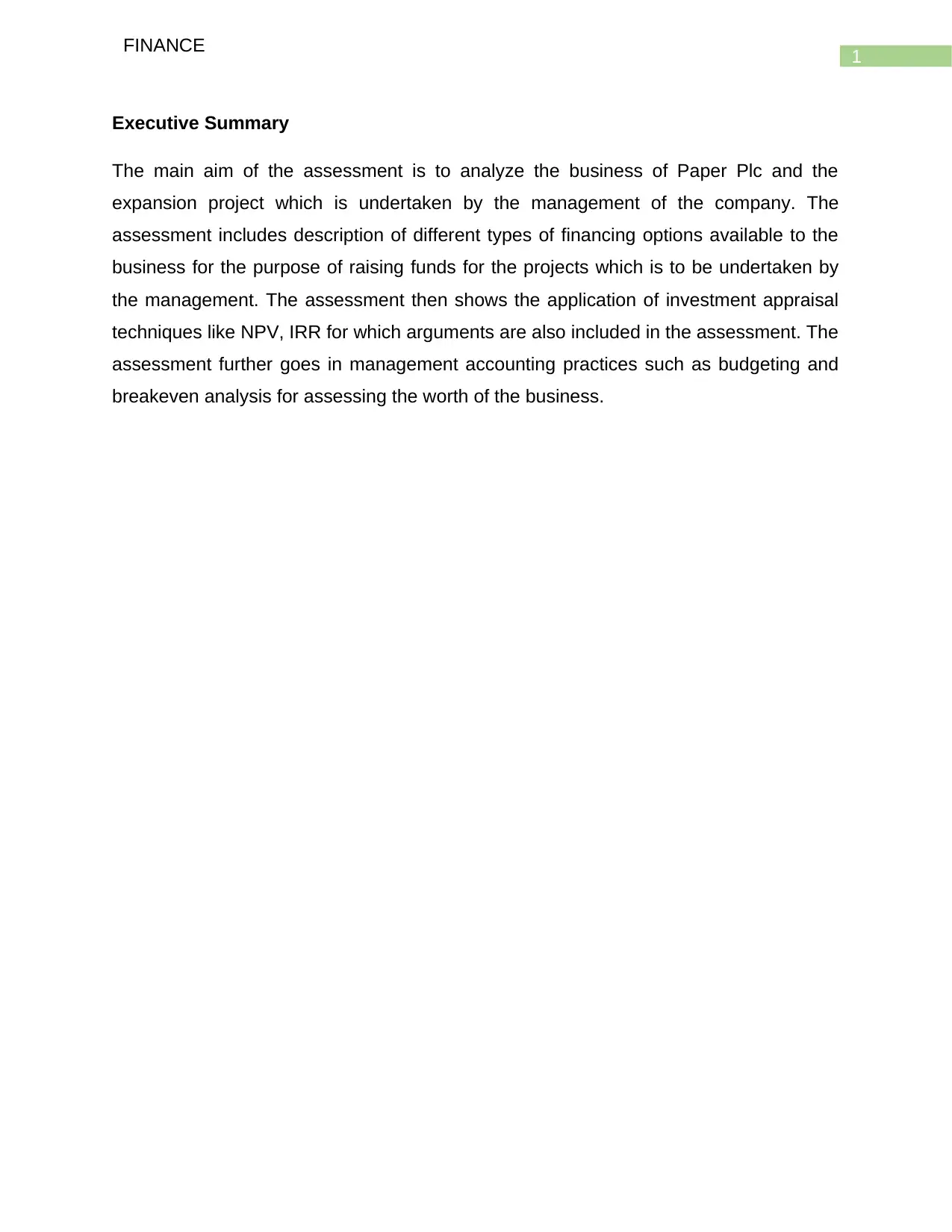
1
FINANCE
Executive Summary
The main aim of the assessment is to analyze the business of Paper Plc and the
expansion project which is undertaken by the management of the company. The
assessment includes description of different types of financing options available to the
business for the purpose of raising funds for the projects which is to be undertaken by
the management. The assessment then shows the application of investment appraisal
techniques like NPV, IRR for which arguments are also included in the assessment. The
assessment further goes in management accounting practices such as budgeting and
breakeven analysis for assessing the worth of the business.
FINANCE
Executive Summary
The main aim of the assessment is to analyze the business of Paper Plc and the
expansion project which is undertaken by the management of the company. The
assessment includes description of different types of financing options available to the
business for the purpose of raising funds for the projects which is to be undertaken by
the management. The assessment then shows the application of investment appraisal
techniques like NPV, IRR for which arguments are also included in the assessment. The
assessment further goes in management accounting practices such as budgeting and
breakeven analysis for assessing the worth of the business.
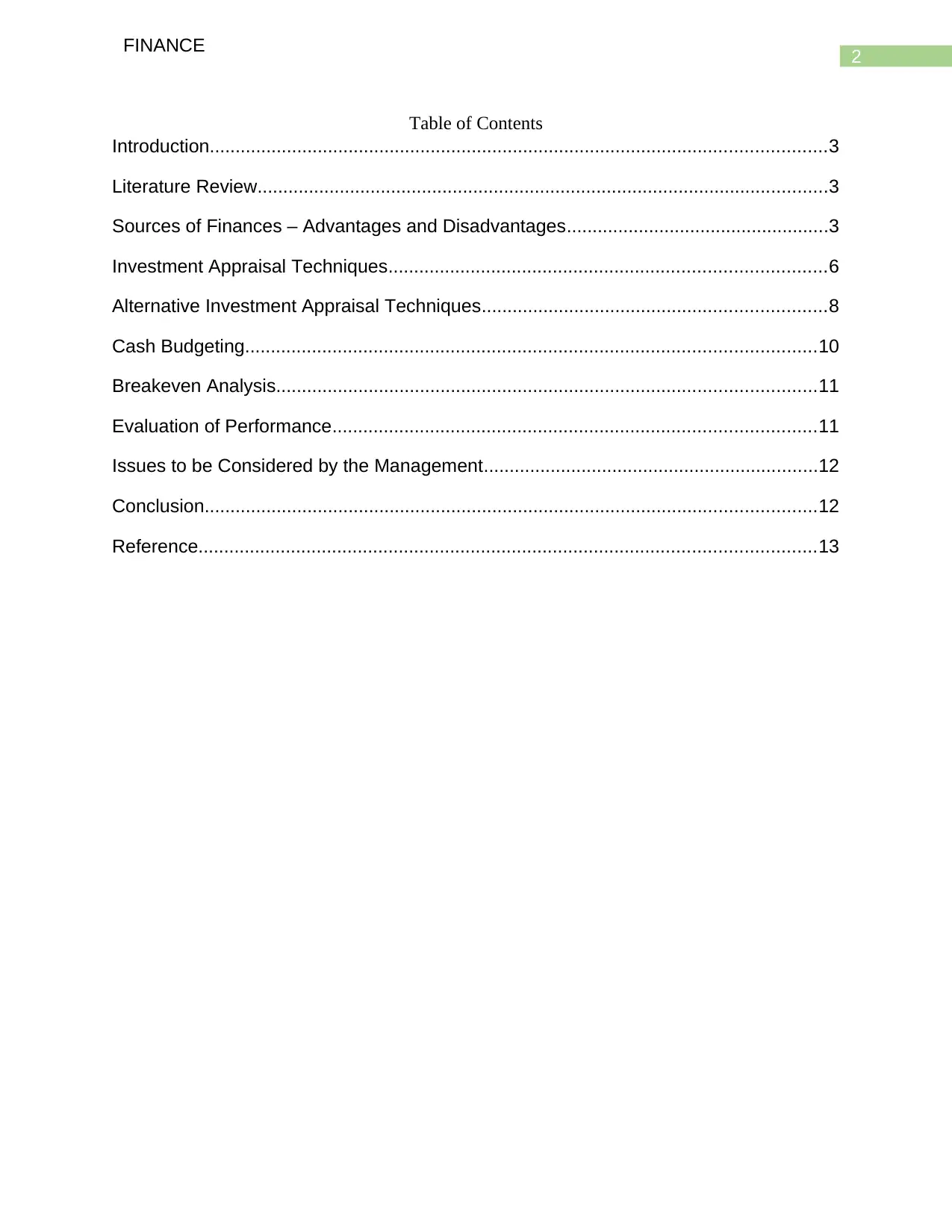
2
FINANCE
Table of Contents
Introduction........................................................................................................................3
Literature Review...............................................................................................................3
Sources of Finances – Advantages and Disadvantages...................................................3
Investment Appraisal Techniques.....................................................................................6
Alternative Investment Appraisal Techniques...................................................................8
Cash Budgeting...............................................................................................................10
Breakeven Analysis.........................................................................................................11
Evaluation of Performance..............................................................................................11
Issues to be Considered by the Management.................................................................12
Conclusion.......................................................................................................................12
Reference........................................................................................................................13
FINANCE
Table of Contents
Introduction........................................................................................................................3
Literature Review...............................................................................................................3
Sources of Finances – Advantages and Disadvantages...................................................3
Investment Appraisal Techniques.....................................................................................6
Alternative Investment Appraisal Techniques...................................................................8
Cash Budgeting...............................................................................................................10
Breakeven Analysis.........................................................................................................11
Evaluation of Performance..............................................................................................11
Issues to be Considered by the Management.................................................................12
Conclusion.......................................................................................................................12
Reference........................................................................................................................13
⊘ This is a preview!⊘
Do you want full access?
Subscribe today to unlock all pages.

Trusted by 1+ million students worldwide
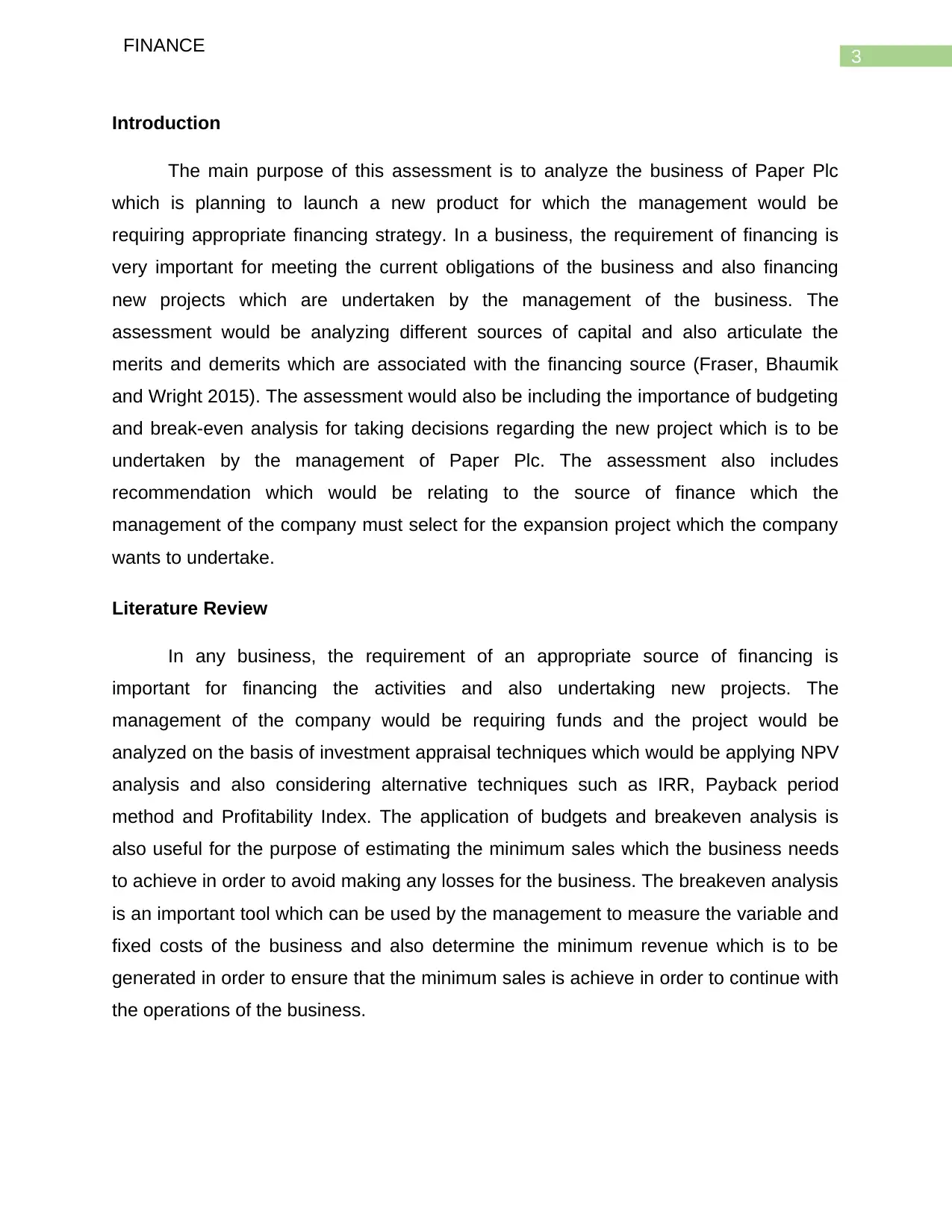
3
FINANCE
Introduction
The main purpose of this assessment is to analyze the business of Paper Plc
which is planning to launch a new product for which the management would be
requiring appropriate financing strategy. In a business, the requirement of financing is
very important for meeting the current obligations of the business and also financing
new projects which are undertaken by the management of the business. The
assessment would be analyzing different sources of capital and also articulate the
merits and demerits which are associated with the financing source (Fraser, Bhaumik
and Wright 2015). The assessment would also be including the importance of budgeting
and break-even analysis for taking decisions regarding the new project which is to be
undertaken by the management of Paper Plc. The assessment also includes
recommendation which would be relating to the source of finance which the
management of the company must select for the expansion project which the company
wants to undertake.
Literature Review
In any business, the requirement of an appropriate source of financing is
important for financing the activities and also undertaking new projects. The
management of the company would be requiring funds and the project would be
analyzed on the basis of investment appraisal techniques which would be applying NPV
analysis and also considering alternative techniques such as IRR, Payback period
method and Profitability Index. The application of budgets and breakeven analysis is
also useful for the purpose of estimating the minimum sales which the business needs
to achieve in order to avoid making any losses for the business. The breakeven analysis
is an important tool which can be used by the management to measure the variable and
fixed costs of the business and also determine the minimum revenue which is to be
generated in order to ensure that the minimum sales is achieve in order to continue with
the operations of the business.
FINANCE
Introduction
The main purpose of this assessment is to analyze the business of Paper Plc
which is planning to launch a new product for which the management would be
requiring appropriate financing strategy. In a business, the requirement of financing is
very important for meeting the current obligations of the business and also financing
new projects which are undertaken by the management of the business. The
assessment would be analyzing different sources of capital and also articulate the
merits and demerits which are associated with the financing source (Fraser, Bhaumik
and Wright 2015). The assessment would also be including the importance of budgeting
and break-even analysis for taking decisions regarding the new project which is to be
undertaken by the management of Paper Plc. The assessment also includes
recommendation which would be relating to the source of finance which the
management of the company must select for the expansion project which the company
wants to undertake.
Literature Review
In any business, the requirement of an appropriate source of financing is
important for financing the activities and also undertaking new projects. The
management of the company would be requiring funds and the project would be
analyzed on the basis of investment appraisal techniques which would be applying NPV
analysis and also considering alternative techniques such as IRR, Payback period
method and Profitability Index. The application of budgets and breakeven analysis is
also useful for the purpose of estimating the minimum sales which the business needs
to achieve in order to avoid making any losses for the business. The breakeven analysis
is an important tool which can be used by the management to measure the variable and
fixed costs of the business and also determine the minimum revenue which is to be
generated in order to ensure that the minimum sales is achieve in order to continue with
the operations of the business.
Paraphrase This Document
Need a fresh take? Get an instant paraphrase of this document with our AI Paraphraser
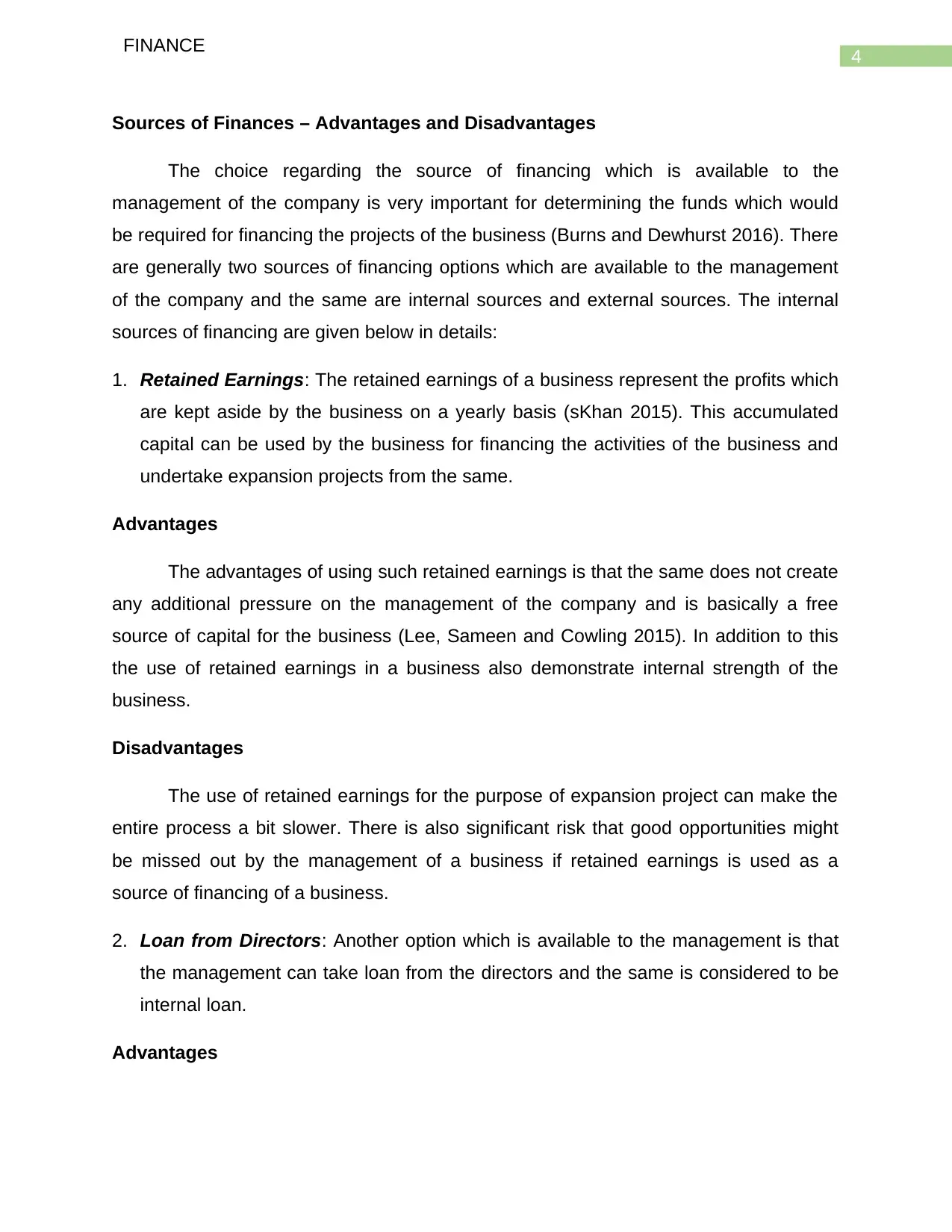
4
FINANCE
Sources of Finances – Advantages and Disadvantages
The choice regarding the source of financing which is available to the
management of the company is very important for determining the funds which would
be required for financing the projects of the business (Burns and Dewhurst 2016). There
are generally two sources of financing options which are available to the management
of the company and the same are internal sources and external sources. The internal
sources of financing are given below in details:
1. Retained Earnings: The retained earnings of a business represent the profits which
are kept aside by the business on a yearly basis (sKhan 2015). This accumulated
capital can be used by the business for financing the activities of the business and
undertake expansion projects from the same.
Advantages
The advantages of using such retained earnings is that the same does not create
any additional pressure on the management of the company and is basically a free
source of capital for the business (Lee, Sameen and Cowling 2015). In addition to this
the use of retained earnings in a business also demonstrate internal strength of the
business.
Disadvantages
The use of retained earnings for the purpose of expansion project can make the
entire process a bit slower. There is also significant risk that good opportunities might
be missed out by the management of a business if retained earnings is used as a
source of financing of a business.
2. Loan from Directors: Another option which is available to the management is that
the management can take loan from the directors and the same is considered to be
internal loan.
Advantages
FINANCE
Sources of Finances – Advantages and Disadvantages
The choice regarding the source of financing which is available to the
management of the company is very important for determining the funds which would
be required for financing the projects of the business (Burns and Dewhurst 2016). There
are generally two sources of financing options which are available to the management
of the company and the same are internal sources and external sources. The internal
sources of financing are given below in details:
1. Retained Earnings: The retained earnings of a business represent the profits which
are kept aside by the business on a yearly basis (sKhan 2015). This accumulated
capital can be used by the business for financing the activities of the business and
undertake expansion projects from the same.
Advantages
The advantages of using such retained earnings is that the same does not create
any additional pressure on the management of the company and is basically a free
source of capital for the business (Lee, Sameen and Cowling 2015). In addition to this
the use of retained earnings in a business also demonstrate internal strength of the
business.
Disadvantages
The use of retained earnings for the purpose of expansion project can make the
entire process a bit slower. There is also significant risk that good opportunities might
be missed out by the management of a business if retained earnings is used as a
source of financing of a business.
2. Loan from Directors: Another option which is available to the management is that
the management can take loan from the directors and the same is considered to be
internal loan.
Advantages
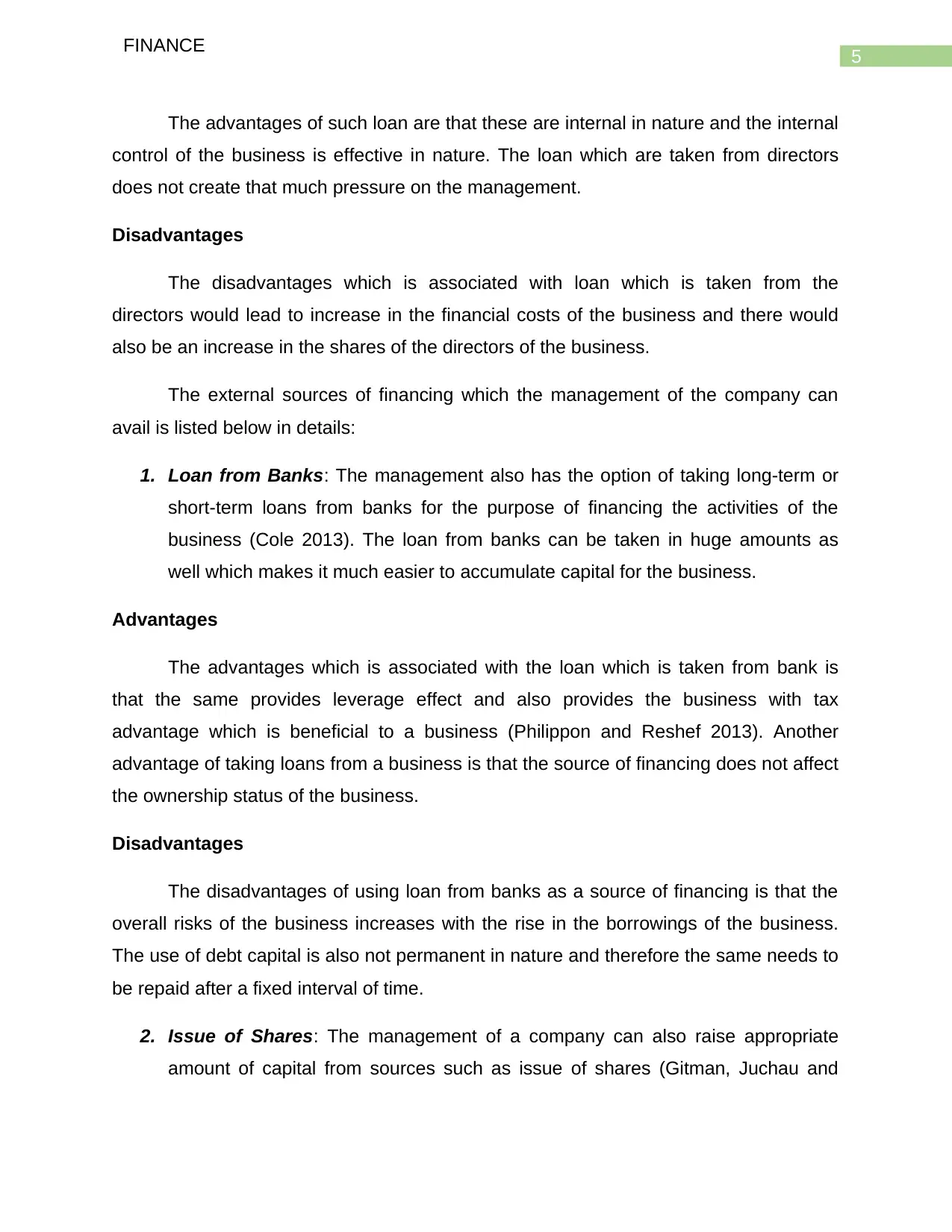
5
FINANCE
The advantages of such loan are that these are internal in nature and the internal
control of the business is effective in nature. The loan which are taken from directors
does not create that much pressure on the management.
Disadvantages
The disadvantages which is associated with loan which is taken from the
directors would lead to increase in the financial costs of the business and there would
also be an increase in the shares of the directors of the business.
The external sources of financing which the management of the company can
avail is listed below in details:
1. Loan from Banks: The management also has the option of taking long-term or
short-term loans from banks for the purpose of financing the activities of the
business (Cole 2013). The loan from banks can be taken in huge amounts as
well which makes it much easier to accumulate capital for the business.
Advantages
The advantages which is associated with the loan which is taken from bank is
that the same provides leverage effect and also provides the business with tax
advantage which is beneficial to a business (Philippon and Reshef 2013). Another
advantage of taking loans from a business is that the source of financing does not affect
the ownership status of the business.
Disadvantages
The disadvantages of using loan from banks as a source of financing is that the
overall risks of the business increases with the rise in the borrowings of the business.
The use of debt capital is also not permanent in nature and therefore the same needs to
be repaid after a fixed interval of time.
2. Issue of Shares: The management of a company can also raise appropriate
amount of capital from sources such as issue of shares (Gitman, Juchau and
FINANCE
The advantages of such loan are that these are internal in nature and the internal
control of the business is effective in nature. The loan which are taken from directors
does not create that much pressure on the management.
Disadvantages
The disadvantages which is associated with loan which is taken from the
directors would lead to increase in the financial costs of the business and there would
also be an increase in the shares of the directors of the business.
The external sources of financing which the management of the company can
avail is listed below in details:
1. Loan from Banks: The management also has the option of taking long-term or
short-term loans from banks for the purpose of financing the activities of the
business (Cole 2013). The loan from banks can be taken in huge amounts as
well which makes it much easier to accumulate capital for the business.
Advantages
The advantages which is associated with the loan which is taken from bank is
that the same provides leverage effect and also provides the business with tax
advantage which is beneficial to a business (Philippon and Reshef 2013). Another
advantage of taking loans from a business is that the source of financing does not affect
the ownership status of the business.
Disadvantages
The disadvantages of using loan from banks as a source of financing is that the
overall risks of the business increases with the rise in the borrowings of the business.
The use of debt capital is also not permanent in nature and therefore the same needs to
be repaid after a fixed interval of time.
2. Issue of Shares: The management of a company can also raise appropriate
amount of capital from sources such as issue of shares (Gitman, Juchau and
⊘ This is a preview!⊘
Do you want full access?
Subscribe today to unlock all pages.

Trusted by 1+ million students worldwide
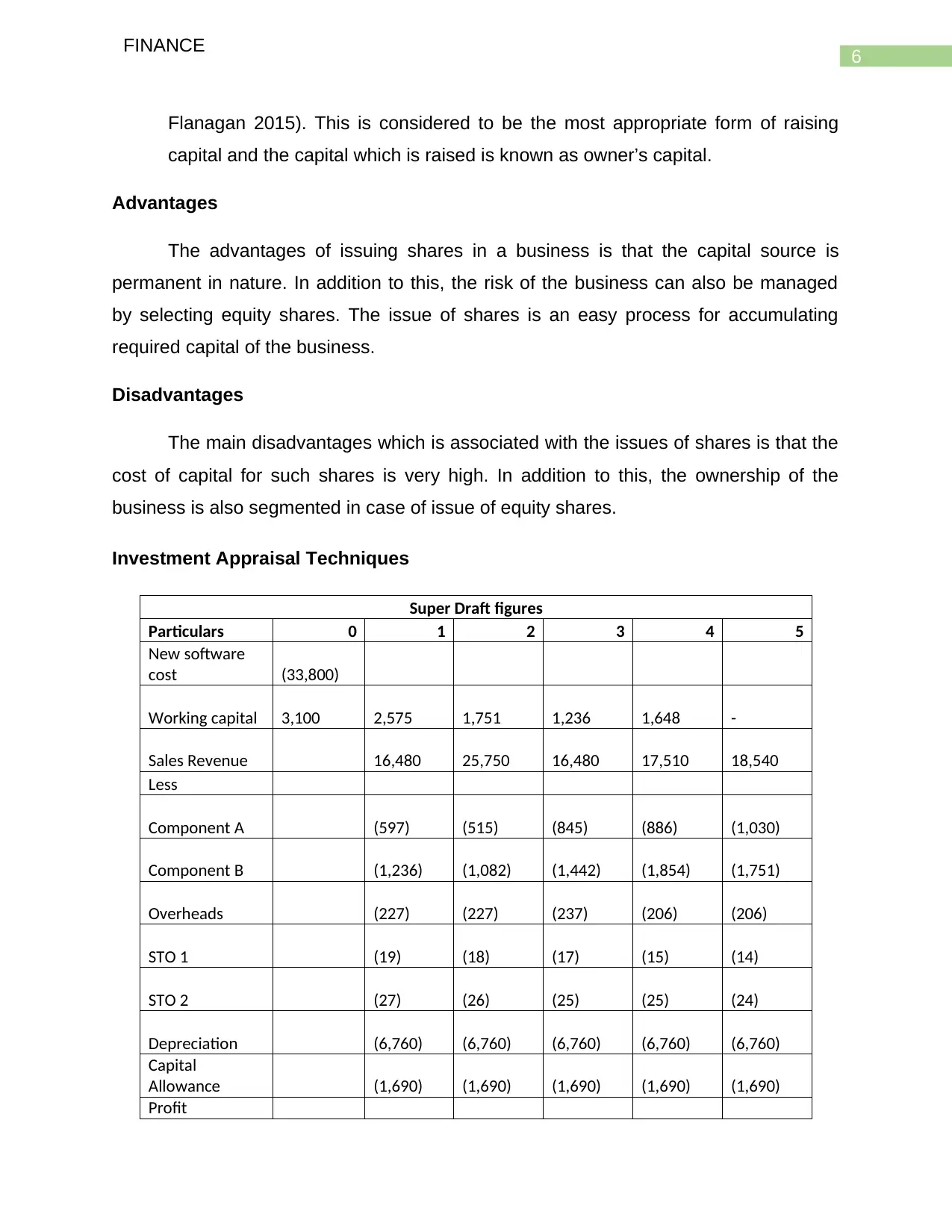
6
FINANCE
Flanagan 2015). This is considered to be the most appropriate form of raising
capital and the capital which is raised is known as owner’s capital.
Advantages
The advantages of issuing shares in a business is that the capital source is
permanent in nature. In addition to this, the risk of the business can also be managed
by selecting equity shares. The issue of shares is an easy process for accumulating
required capital of the business.
Disadvantages
The main disadvantages which is associated with the issues of shares is that the
cost of capital for such shares is very high. In addition to this, the ownership of the
business is also segmented in case of issue of equity shares.
Investment Appraisal Techniques
Super Draft figures
Particulars 0 1 2 3 4 5
New software
cost (33,800)
Working capital 3,100 2,575 1,751 1,236 1,648 -
Sales Revenue 16,480 25,750 16,480 17,510 18,540
Less
Component A (597) (515) (845) (886) (1,030)
Component B (1,236) (1,082) (1,442) (1,854) (1,751)
Overheads (227) (227) (237) (206) (206)
STO 1 (19) (18) (17) (15) (14)
STO 2 (27) (26) (25) (25) (24)
Depreciation (6,760) (6,760) (6,760) (6,760) (6,760)
Capital
Allowance (1,690) (1,690) (1,690) (1,690) (1,690)
Profit
FINANCE
Flanagan 2015). This is considered to be the most appropriate form of raising
capital and the capital which is raised is known as owner’s capital.
Advantages
The advantages of issuing shares in a business is that the capital source is
permanent in nature. In addition to this, the risk of the business can also be managed
by selecting equity shares. The issue of shares is an easy process for accumulating
required capital of the business.
Disadvantages
The main disadvantages which is associated with the issues of shares is that the
cost of capital for such shares is very high. In addition to this, the ownership of the
business is also segmented in case of issue of equity shares.
Investment Appraisal Techniques
Super Draft figures
Particulars 0 1 2 3 4 5
New software
cost (33,800)
Working capital 3,100 2,575 1,751 1,236 1,648 -
Sales Revenue 16,480 25,750 16,480 17,510 18,540
Less
Component A (597) (515) (845) (886) (1,030)
Component B (1,236) (1,082) (1,442) (1,854) (1,751)
Overheads (227) (227) (237) (206) (206)
STO 1 (19) (18) (17) (15) (14)
STO 2 (27) (26) (25) (25) (24)
Depreciation (6,760) (6,760) (6,760) (6,760) (6,760)
Capital
Allowance (1,690) (1,690) (1,690) (1,690) (1,690)
Profit
Paraphrase This Document
Need a fresh take? Get an instant paraphrase of this document with our AI Paraphraser
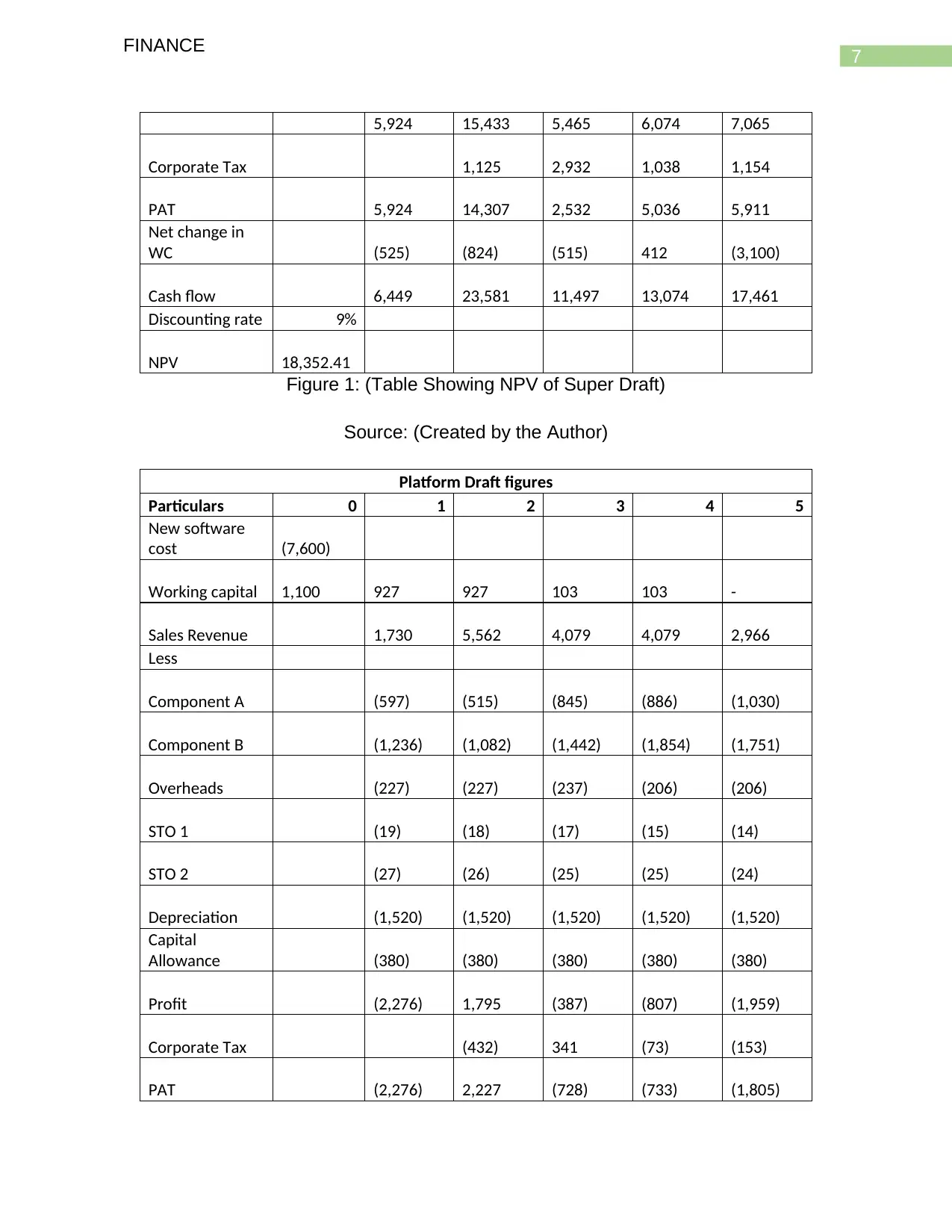
7
FINANCE
5,924 15,433 5,465 6,074 7,065
Corporate Tax 1,125 2,932 1,038 1,154
PAT 5,924 14,307 2,532 5,036 5,911
Net change in
WC (525) (824) (515) 412 (3,100)
Cash flow 6,449 23,581 11,497 13,074 17,461
Discounting rate 9%
NPV 18,352.41
Figure 1: (Table Showing NPV of Super Draft)
Source: (Created by the Author)
Platform Draft figures
Particulars 0 1 2 3 4 5
New software
cost (7,600)
Working capital 1,100 927 927 103 103 -
Sales Revenue 1,730 5,562 4,079 4,079 2,966
Less
Component A (597) (515) (845) (886) (1,030)
Component B (1,236) (1,082) (1,442) (1,854) (1,751)
Overheads (227) (227) (237) (206) (206)
STO 1 (19) (18) (17) (15) (14)
STO 2 (27) (26) (25) (25) (24)
Depreciation (1,520) (1,520) (1,520) (1,520) (1,520)
Capital
Allowance (380) (380) (380) (380) (380)
Profit (2,276) 1,795 (387) (807) (1,959)
Corporate Tax (432) 341 (73) (153)
PAT (2,276) 2,227 (728) (733) (1,805)
FINANCE
5,924 15,433 5,465 6,074 7,065
Corporate Tax 1,125 2,932 1,038 1,154
PAT 5,924 14,307 2,532 5,036 5,911
Net change in
WC (525) (824) (515) 412 (3,100)
Cash flow 6,449 23,581 11,497 13,074 17,461
Discounting rate 9%
NPV 18,352.41
Figure 1: (Table Showing NPV of Super Draft)
Source: (Created by the Author)
Platform Draft figures
Particulars 0 1 2 3 4 5
New software
cost (7,600)
Working capital 1,100 927 927 103 103 -
Sales Revenue 1,730 5,562 4,079 4,079 2,966
Less
Component A (597) (515) (845) (886) (1,030)
Component B (1,236) (1,082) (1,442) (1,854) (1,751)
Overheads (227) (227) (237) (206) (206)
STO 1 (19) (18) (17) (15) (14)
STO 2 (27) (26) (25) (25) (24)
Depreciation (1,520) (1,520) (1,520) (1,520) (1,520)
Capital
Allowance (380) (380) (380) (380) (380)
Profit (2,276) 1,795 (387) (807) (1,959)
Corporate Tax (432) 341 (73) (153)
PAT (2,276) 2,227 (728) (733) (1,805)
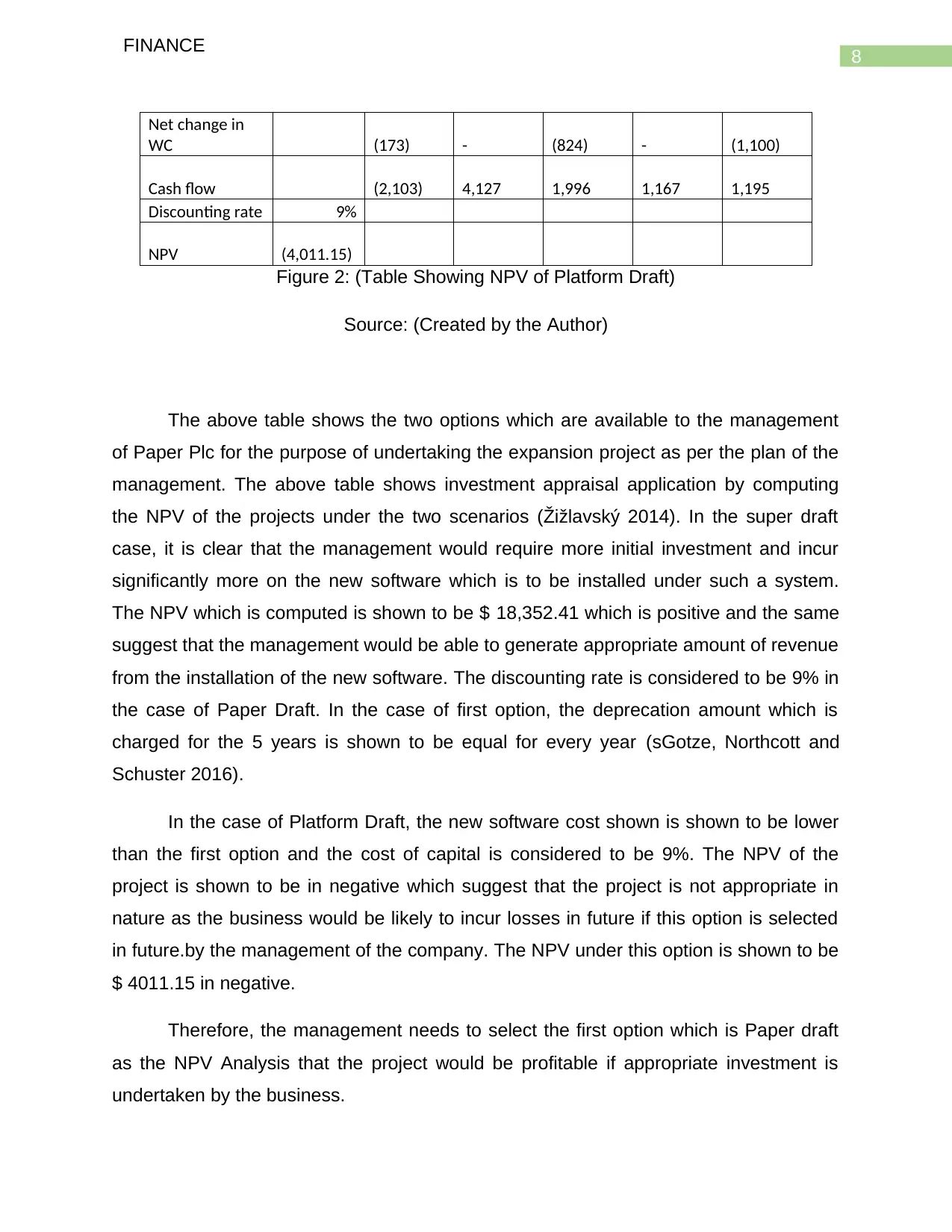
8
FINANCE
Net change in
WC (173) - (824) - (1,100)
Cash flow (2,103) 4,127 1,996 1,167 1,195
Discounting rate 9%
NPV (4,011.15)
Figure 2: (Table Showing NPV of Platform Draft)
Source: (Created by the Author)
The above table shows the two options which are available to the management
of Paper Plc for the purpose of undertaking the expansion project as per the plan of the
management. The above table shows investment appraisal application by computing
the NPV of the projects under the two scenarios (Žižlavský 2014). In the super draft
case, it is clear that the management would require more initial investment and incur
significantly more on the new software which is to be installed under such a system.
The NPV which is computed is shown to be $ 18,352.41 which is positive and the same
suggest that the management would be able to generate appropriate amount of revenue
from the installation of the new software. The discounting rate is considered to be 9% in
the case of Paper Draft. In the case of first option, the deprecation amount which is
charged for the 5 years is shown to be equal for every year (sGotze, Northcott and
Schuster 2016).
In the case of Platform Draft, the new software cost shown is shown to be lower
than the first option and the cost of capital is considered to be 9%. The NPV of the
project is shown to be in negative which suggest that the project is not appropriate in
nature as the business would be likely to incur losses in future if this option is selected
in future.by the management of the company. The NPV under this option is shown to be
$ 4011.15 in negative.
Therefore, the management needs to select the first option which is Paper draft
as the NPV Analysis that the project would be profitable if appropriate investment is
undertaken by the business.
FINANCE
Net change in
WC (173) - (824) - (1,100)
Cash flow (2,103) 4,127 1,996 1,167 1,195
Discounting rate 9%
NPV (4,011.15)
Figure 2: (Table Showing NPV of Platform Draft)
Source: (Created by the Author)
The above table shows the two options which are available to the management
of Paper Plc for the purpose of undertaking the expansion project as per the plan of the
management. The above table shows investment appraisal application by computing
the NPV of the projects under the two scenarios (Žižlavský 2014). In the super draft
case, it is clear that the management would require more initial investment and incur
significantly more on the new software which is to be installed under such a system.
The NPV which is computed is shown to be $ 18,352.41 which is positive and the same
suggest that the management would be able to generate appropriate amount of revenue
from the installation of the new software. The discounting rate is considered to be 9% in
the case of Paper Draft. In the case of first option, the deprecation amount which is
charged for the 5 years is shown to be equal for every year (sGotze, Northcott and
Schuster 2016).
In the case of Platform Draft, the new software cost shown is shown to be lower
than the first option and the cost of capital is considered to be 9%. The NPV of the
project is shown to be in negative which suggest that the project is not appropriate in
nature as the business would be likely to incur losses in future if this option is selected
in future.by the management of the company. The NPV under this option is shown to be
$ 4011.15 in negative.
Therefore, the management needs to select the first option which is Paper draft
as the NPV Analysis that the project would be profitable if appropriate investment is
undertaken by the business.
⊘ This is a preview!⊘
Do you want full access?
Subscribe today to unlock all pages.

Trusted by 1+ million students worldwide
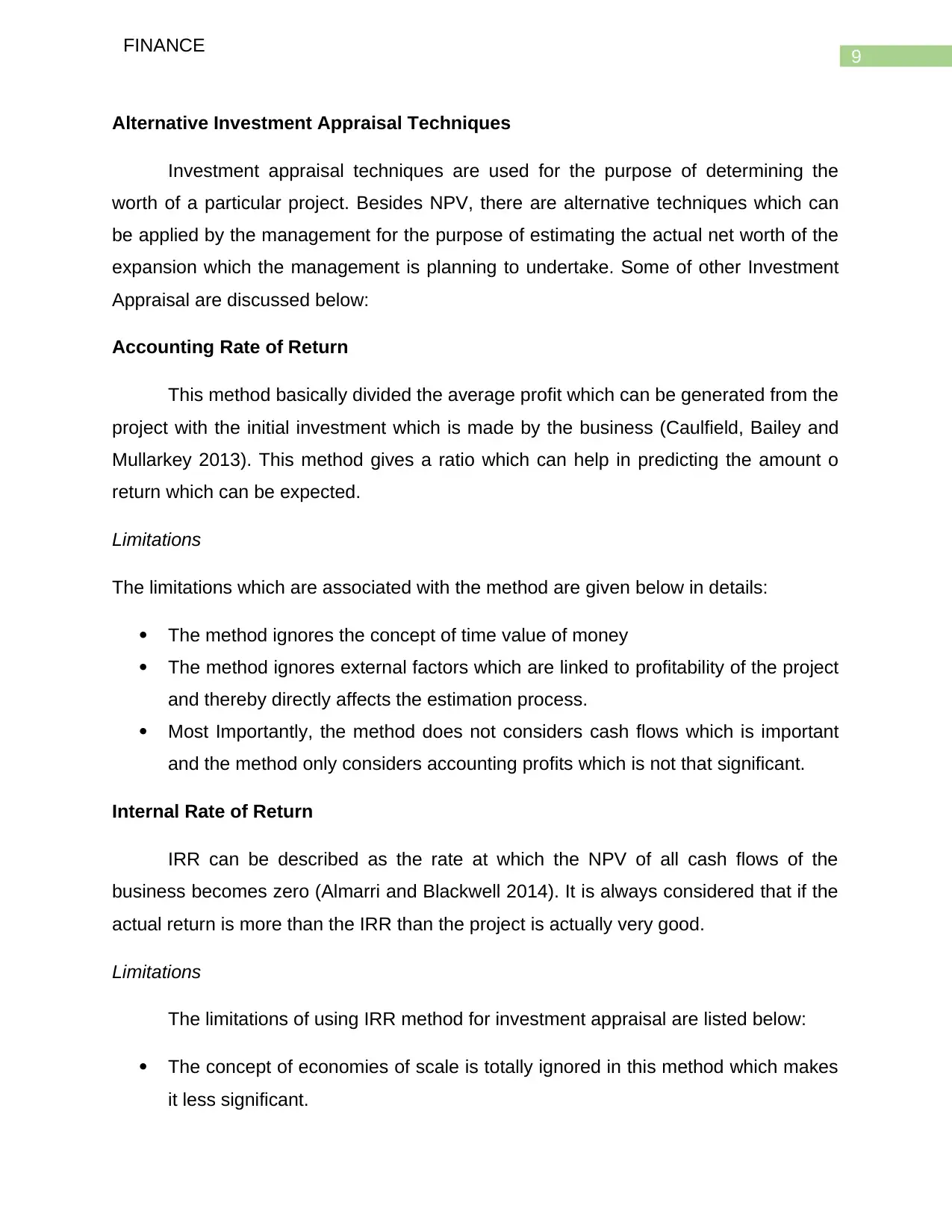
9
FINANCE
Alternative Investment Appraisal Techniques
Investment appraisal techniques are used for the purpose of determining the
worth of a particular project. Besides NPV, there are alternative techniques which can
be applied by the management for the purpose of estimating the actual net worth of the
expansion which the management is planning to undertake. Some of other Investment
Appraisal are discussed below:
Accounting Rate of Return
This method basically divided the average profit which can be generated from the
project with the initial investment which is made by the business (Caulfield, Bailey and
Mullarkey 2013). This method gives a ratio which can help in predicting the amount o
return which can be expected.
Limitations
The limitations which are associated with the method are given below in details:
The method ignores the concept of time value of money
The method ignores external factors which are linked to profitability of the project
and thereby directly affects the estimation process.
Most Importantly, the method does not considers cash flows which is important
and the method only considers accounting profits which is not that significant.
Internal Rate of Return
IRR can be described as the rate at which the NPV of all cash flows of the
business becomes zero (Almarri and Blackwell 2014). It is always considered that if the
actual return is more than the IRR than the project is actually very good.
Limitations
The limitations of using IRR method for investment appraisal are listed below:
The concept of economies of scale is totally ignored in this method which makes
it less significant.
FINANCE
Alternative Investment Appraisal Techniques
Investment appraisal techniques are used for the purpose of determining the
worth of a particular project. Besides NPV, there are alternative techniques which can
be applied by the management for the purpose of estimating the actual net worth of the
expansion which the management is planning to undertake. Some of other Investment
Appraisal are discussed below:
Accounting Rate of Return
This method basically divided the average profit which can be generated from the
project with the initial investment which is made by the business (Caulfield, Bailey and
Mullarkey 2013). This method gives a ratio which can help in predicting the amount o
return which can be expected.
Limitations
The limitations which are associated with the method are given below in details:
The method ignores the concept of time value of money
The method ignores external factors which are linked to profitability of the project
and thereby directly affects the estimation process.
Most Importantly, the method does not considers cash flows which is important
and the method only considers accounting profits which is not that significant.
Internal Rate of Return
IRR can be described as the rate at which the NPV of all cash flows of the
business becomes zero (Almarri and Blackwell 2014). It is always considered that if the
actual return is more than the IRR than the project is actually very good.
Limitations
The limitations of using IRR method for investment appraisal are listed below:
The concept of economies of scale is totally ignored in this method which makes
it less significant.
Paraphrase This Document
Need a fresh take? Get an instant paraphrase of this document with our AI Paraphraser
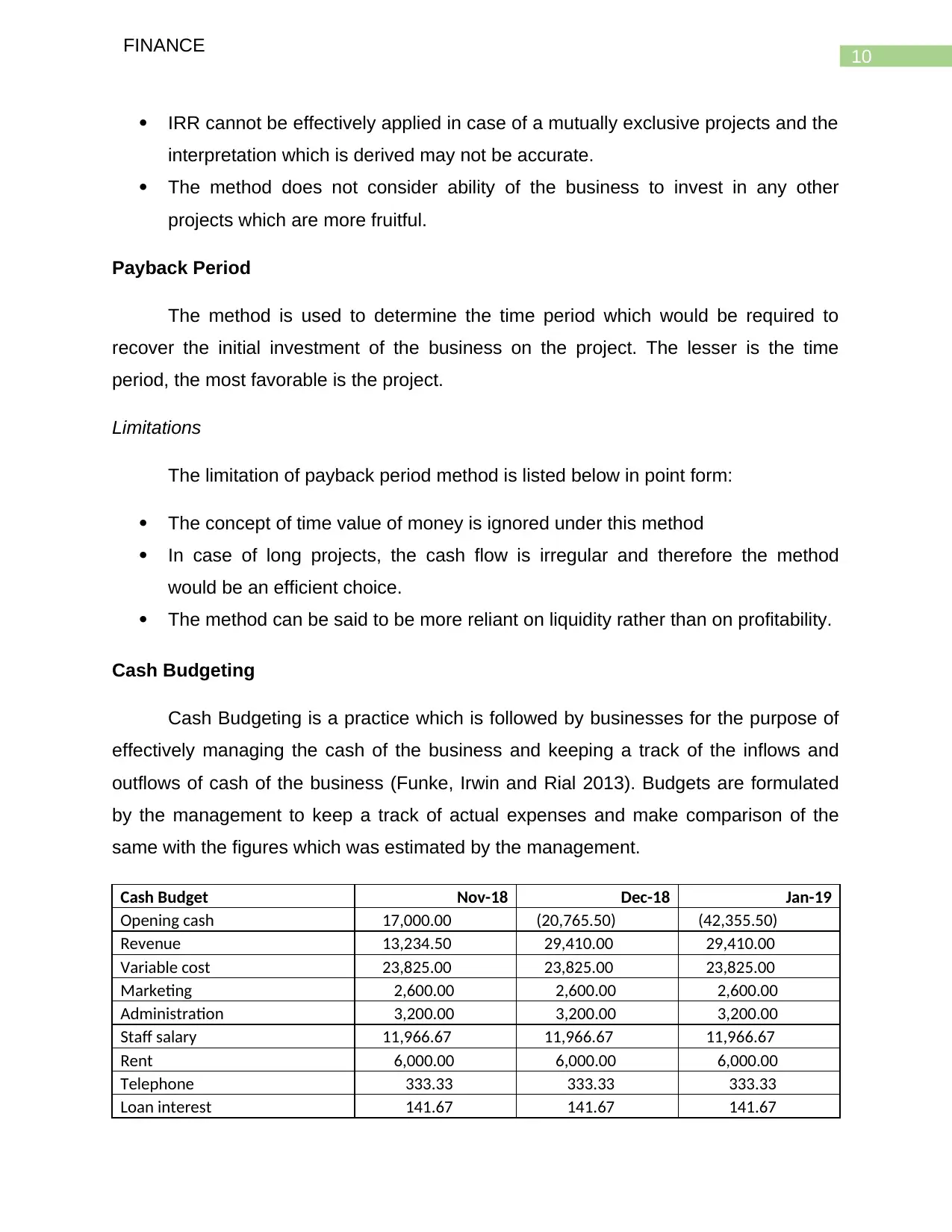
10
FINANCE
IRR cannot be effectively applied in case of a mutually exclusive projects and the
interpretation which is derived may not be accurate.
The method does not consider ability of the business to invest in any other
projects which are more fruitful.
Payback Period
The method is used to determine the time period which would be required to
recover the initial investment of the business on the project. The lesser is the time
period, the most favorable is the project.
Limitations
The limitation of payback period method is listed below in point form:
The concept of time value of money is ignored under this method
In case of long projects, the cash flow is irregular and therefore the method
would be an efficient choice.
The method can be said to be more reliant on liquidity rather than on profitability.
Cash Budgeting
Cash Budgeting is a practice which is followed by businesses for the purpose of
effectively managing the cash of the business and keeping a track of the inflows and
outflows of cash of the business (Funke, Irwin and Rial 2013). Budgets are formulated
by the management to keep a track of actual expenses and make comparison of the
same with the figures which was estimated by the management.
Cash Budget Nov-18 Dec-18 Jan-19
Opening cash 17,000.00 (20,765.50) (42,355.50)
Revenue 13,234.50 29,410.00 29,410.00
Variable cost 23,825.00 23,825.00 23,825.00
Marketing 2,600.00 2,600.00 2,600.00
Administration 3,200.00 3,200.00 3,200.00
Staff salary 11,966.67 11,966.67 11,966.67
Rent 6,000.00 6,000.00 6,000.00
Telephone 333.33 333.33 333.33
Loan interest 141.67 141.67 141.67
FINANCE
IRR cannot be effectively applied in case of a mutually exclusive projects and the
interpretation which is derived may not be accurate.
The method does not consider ability of the business to invest in any other
projects which are more fruitful.
Payback Period
The method is used to determine the time period which would be required to
recover the initial investment of the business on the project. The lesser is the time
period, the most favorable is the project.
Limitations
The limitation of payback period method is listed below in point form:
The concept of time value of money is ignored under this method
In case of long projects, the cash flow is irregular and therefore the method
would be an efficient choice.
The method can be said to be more reliant on liquidity rather than on profitability.
Cash Budgeting
Cash Budgeting is a practice which is followed by businesses for the purpose of
effectively managing the cash of the business and keeping a track of the inflows and
outflows of cash of the business (Funke, Irwin and Rial 2013). Budgets are formulated
by the management to keep a track of actual expenses and make comparison of the
same with the figures which was estimated by the management.
Cash Budget Nov-18 Dec-18 Jan-19
Opening cash 17,000.00 (20,765.50) (42,355.50)
Revenue 13,234.50 29,410.00 29,410.00
Variable cost 23,825.00 23,825.00 23,825.00
Marketing 2,600.00 2,600.00 2,600.00
Administration 3,200.00 3,200.00 3,200.00
Staff salary 11,966.67 11,966.67 11,966.67
Rent 6,000.00 6,000.00 6,000.00
Telephone 333.33 333.33 333.33
Loan interest 141.67 141.67 141.67
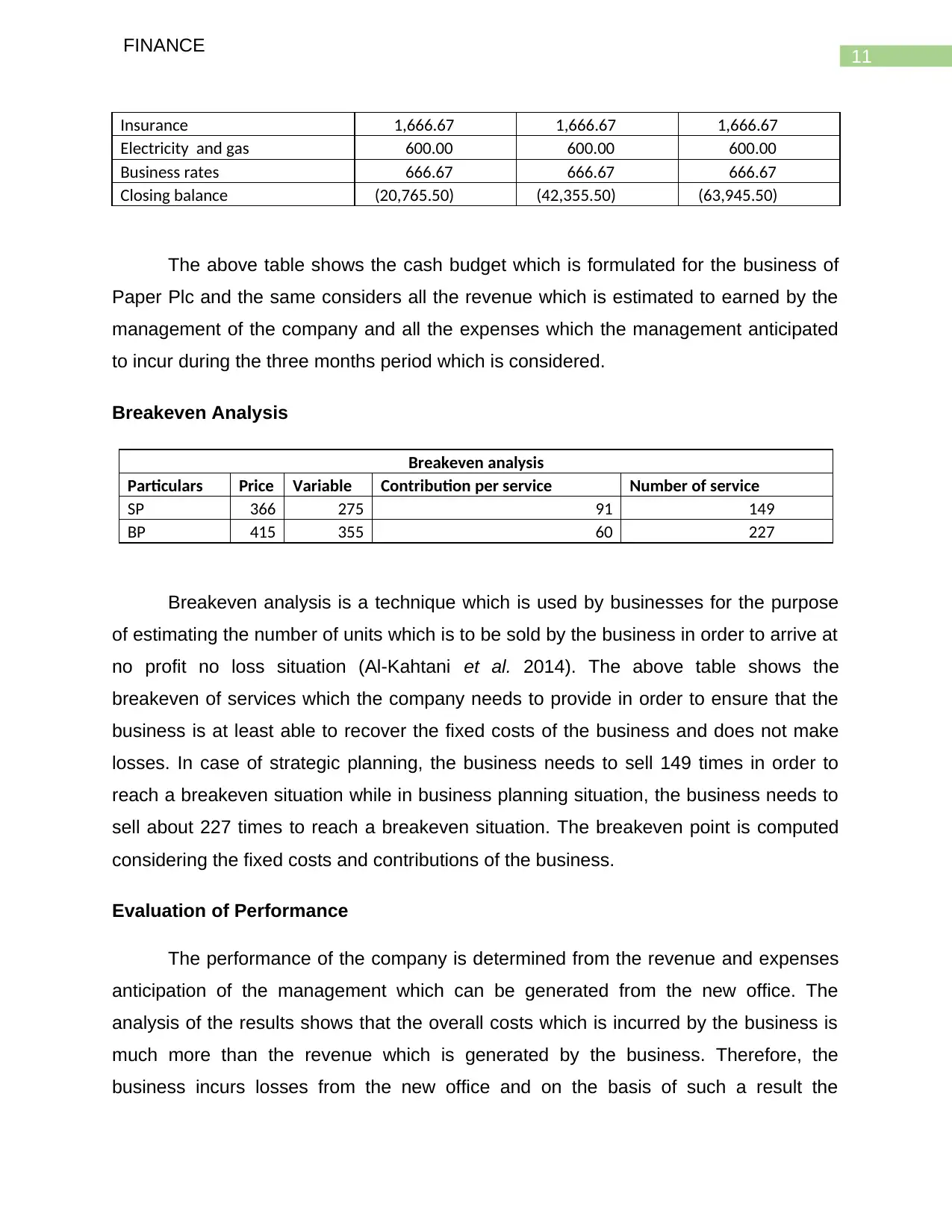
11
FINANCE
Insurance 1,666.67 1,666.67 1,666.67
Electricity and gas 600.00 600.00 600.00
Business rates 666.67 666.67 666.67
Closing balance (20,765.50) (42,355.50) (63,945.50)
The above table shows the cash budget which is formulated for the business of
Paper Plc and the same considers all the revenue which is estimated to earned by the
management of the company and all the expenses which the management anticipated
to incur during the three months period which is considered.
Breakeven Analysis
Breakeven analysis
Particulars Price Variable Contribution per service Number of service
SP 366 275 91 149
BP 415 355 60 227
Breakeven analysis is a technique which is used by businesses for the purpose
of estimating the number of units which is to be sold by the business in order to arrive at
no profit no loss situation (Al-Kahtani et al. 2014). The above table shows the
breakeven of services which the company needs to provide in order to ensure that the
business is at least able to recover the fixed costs of the business and does not make
losses. In case of strategic planning, the business needs to sell 149 times in order to
reach a breakeven situation while in business planning situation, the business needs to
sell about 227 times to reach a breakeven situation. The breakeven point is computed
considering the fixed costs and contributions of the business.
Evaluation of Performance
The performance of the company is determined from the revenue and expenses
anticipation of the management which can be generated from the new office. The
analysis of the results shows that the overall costs which is incurred by the business is
much more than the revenue which is generated by the business. Therefore, the
business incurs losses from the new office and on the basis of such a result the
FINANCE
Insurance 1,666.67 1,666.67 1,666.67
Electricity and gas 600.00 600.00 600.00
Business rates 666.67 666.67 666.67
Closing balance (20,765.50) (42,355.50) (63,945.50)
The above table shows the cash budget which is formulated for the business of
Paper Plc and the same considers all the revenue which is estimated to earned by the
management of the company and all the expenses which the management anticipated
to incur during the three months period which is considered.
Breakeven Analysis
Breakeven analysis
Particulars Price Variable Contribution per service Number of service
SP 366 275 91 149
BP 415 355 60 227
Breakeven analysis is a technique which is used by businesses for the purpose
of estimating the number of units which is to be sold by the business in order to arrive at
no profit no loss situation (Al-Kahtani et al. 2014). The above table shows the
breakeven of services which the company needs to provide in order to ensure that the
business is at least able to recover the fixed costs of the business and does not make
losses. In case of strategic planning, the business needs to sell 149 times in order to
reach a breakeven situation while in business planning situation, the business needs to
sell about 227 times to reach a breakeven situation. The breakeven point is computed
considering the fixed costs and contributions of the business.
Evaluation of Performance
The performance of the company is determined from the revenue and expenses
anticipation of the management which can be generated from the new office. The
analysis of the results shows that the overall costs which is incurred by the business is
much more than the revenue which is generated by the business. Therefore, the
business incurs losses from the new office and on the basis of such a result the
⊘ This is a preview!⊘
Do you want full access?
Subscribe today to unlock all pages.

Trusted by 1+ million students worldwide
1 out of 15
Related Documents
Your All-in-One AI-Powered Toolkit for Academic Success.
+13062052269
info@desklib.com
Available 24*7 on WhatsApp / Email
![[object Object]](/_next/static/media/star-bottom.7253800d.svg)
Unlock your academic potential
Copyright © 2020–2025 A2Z Services. All Rights Reserved. Developed and managed by ZUCOL.





